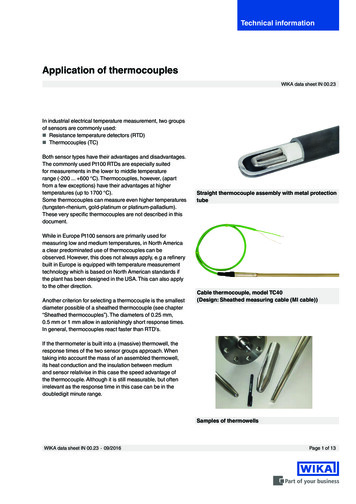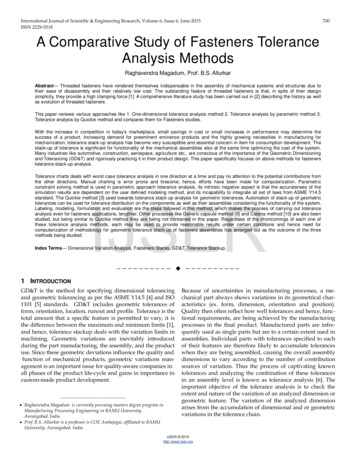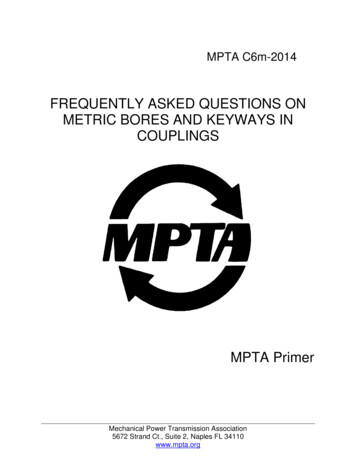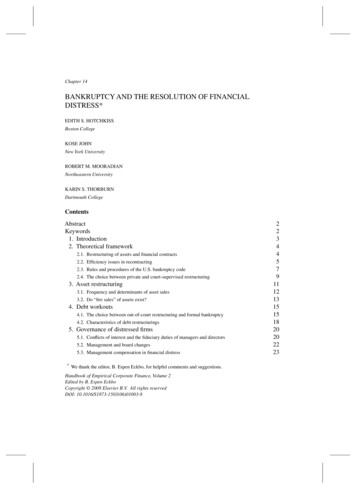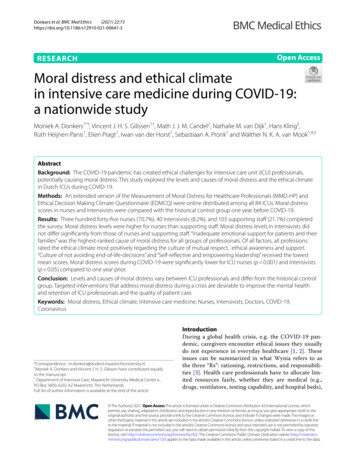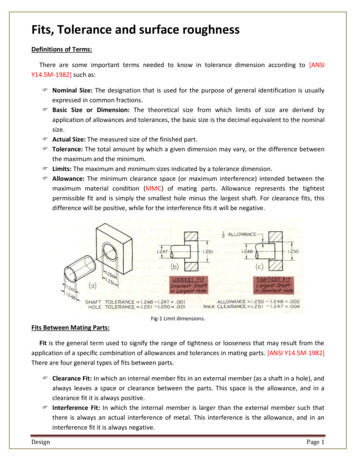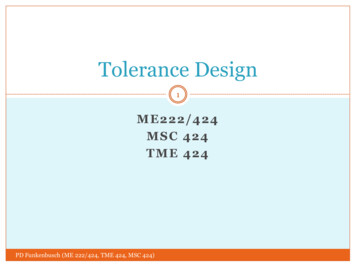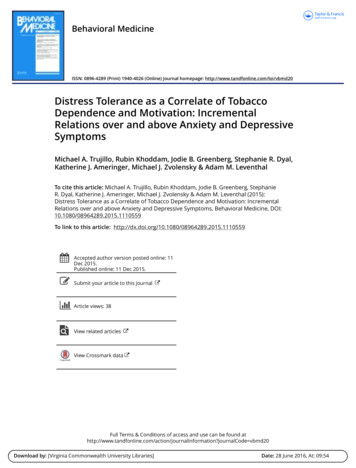
Transcription
Behavioral MedicineISSN: 0896-4289 (Print) 1940-4026 (Online) Journal homepage: http://www.tandfonline.com/loi/vbmd20Distress Tolerance as a Correlate of TobaccoDependence and Motivation: IncrementalRelations over and above Anxiety and DepressiveSymptomsMichael A. Trujillo, Rubin Khoddam, Jodie B. Greenberg, Stephanie R. Dyal,Katherine J. Ameringer, Michael J. Zvolensky & Adam M. LeventhalTo cite this article: Michael A. Trujillo, Rubin Khoddam, Jodie B. Greenberg, StephanieR. Dyal, Katherine J. Ameringer, Michael J. Zvolensky & Adam M. Leventhal (2015):Distress Tolerance as a Correlate of Tobacco Dependence and Motivation: IncrementalRelations over and above Anxiety and Depressive Symptoms, Behavioral Medicine, DOI:10.1080/08964289.2015.1110559To link to this article: epted author version posted online: 11Dec 2015.Published online: 11 Dec 2015.Submit your article to this journalArticle views: 38View related articlesView Crossmark dataFull Terms & Conditions of access and use can be found tion?journalCode vbmd20Download by: [Virginia Commonwealth University Libraries]Date: 28 June 2016, At: 09:54
BEHAVIORAL MEDICINE2016, VOL. 0, NO. 0, 59Distress Tolerance as a Correlate of Tobacco Dependence and Motivation:Incremental Relations over and above Anxiety and Depressive SymptomsMichael A. Trujilloa, Rubin Khoddamb, Jodie B. Greenbergb, Stephanie R. Dyalb, Katherine J. Ameringerb,Michael J. Zvolenskyc, and Adam M. Leventhald,bDownloaded by [Virginia Commonwealth University Libraries] at 09:54 28 June 2016aVirginia Commonwealth University; bUniversity of Southern California Keck School of Medicine; cUniversity of Houston and University of TexasM. D. Anderson Cancer Center; dUniversity of Southern CaliforniaABSTRACTKEYWORDSDistress tolerance—the capacity to withstand distressing states—is implicated in the etiology ofregular smoking. The present study extends past resarch by examining whether relations betweenperceived distress tolerance and smoking-related factors: (1) differ across subdimensions of distresstolerance (Tolerance, Appraisal, Regulation, Absorption); (2) extend across measures of dependence,negative reinforcement smoking, and craving; and (3) are incremental to depressive and anxietysymptoms. Results showed that global distress tolerance was associated with measures ofdependence, negative reinforcement, and craving even after controlling for affectivesymptomatology. Subdimensions of distress tolerance were not uniquely related to smokingoutcomes in unadjusted or adjusted models. These findings suggest that: (a) distress tolerance isuniquely implicated in smoking over and above affective symptomatology; and (b) specificsubdimensions of distress tolerance do not provide more information about smoking-relatedcharacteristics than global dimensions; and (c) addressing distress tolerance in smoking cessationinterventions may promote successful cessation.anxiety; dependence;depression; distresstolerance; nicotine; smokingIntroductionDistress tolerance reflects the perceived or actual abilityto withstand negative affect or other aversive psychological or physical states and continues to be an area of focusfor clinical researchers and practitioners as it has beenpurported to contribute to several forms of psychopathology including smoking.1 Researchers have found distress tolerance to have a hierarchical structure withdomain general and domain specific properties. Namely,there is a global “experiential distress intolerance” construct with five lower-order constructs tapping the perceived capacity to tolerate distress (frustrationintolerance, ambiguity intolerance, physical discomfortintolerance, and intolerance of negative emotions).2 Provided that distress tolerance has been implicated in theetiology of regular smoking,3 it would be important toassess how global distress tolerance and its subdimensions differentially relate to aspects of the dependencesyndrome including craving and negative reinforcementsmoking—two important constructs of the dependencesyndrome worthy of further examination.Existing research has identified how exploring distress tolerance in relation to smoking continues to beCONTACT Adam M. LeventhalLos Angeles, CA 90033, USA 2016 Taylor & Francis Group, LLCadam.leventhal@usc.eduof significant importance. A wealth of literature hasidentified that low distress tolerance among smokersis associated with greater likelihood of being a lifetime smoker4 and is related to shorter durations ofabstinence from smoking during a quit attempt.5–7Theory on substance use behavior and distress tolerance has posited that people with low distress tolerance may be inclined towards substance use toescape/avoid or reduce the aversive state.8 Indeed,smoking is purported to alleviate negative affect,9which may increase vulnerability to smoking persistence and dependence.5 Measures of tobacco-dependence severity (eg, Fagerstr om Test of NicotineDependence),4 cigarette craving (ie, subjective desireto smoke),13 and negative reinforcement smoking14are highly relevant factors in smoking behaviorbecause they are strongly predictive of greater likelihood of relapse after cessation.15 Furthermore, eachof these factors are either direct indicators of tobaccoaddiction, an element of the addiction syndrome (eg,craving is a symptom of DSM-5 tobacco use disorder)16 or central to theories of tobacco addictionmotivation (eg, negative reinforcement is believed toPhD, University of Southern California Keck School of Medicine, 2250 Alcazar Street, CSC 240,
Downloaded by [Virginia Commonwealth University Libraries] at 09:54 28 June 20162M. A. TRUJILLO ET AL.play a central role in maintaining addictive smokingbehavior).17 Moreover, dependence, craving, and negative reinforcement would presumably reflect theaspect through which low distress tolerance wouldimpact smoking behavior as individuals who areunable to tolerate distress would be driven to smokein the presence of compulsive physiological-relateddependency, strong cravings to smoke, and themotive to alleviate negative affect. Overall this suggests that distress tolerance may be a suitable explanatory model for smoking motive and maintanence.Based upon these and related findings, subsequentwork has sought to ‘cultivate’ distress tolerance prior toquitting and during treatment in order to facilitate successin remaining abstinent among smokers10,11 and improvedistress tolerance in patients with substance use disorder.12Evidence from these studies suggests that distress tolerance as a component in treatment may prove useful forsmoking cessation treatment. Therefore modification ofdistress tolerance via the use of exposure-based andAcceptance and Commitment Therapy-based treatment,10,11 may be of use in clinical practice. Thus, furtherclarification of the relation between distress tolerance andsmoking is of both theoretical and clinical value.One means of elucidating the role of distress tolerance, that is the perceived ability to withstand aversivestates, in smoking is to identify which subfacets of distress tolerance are uniquely implicated in smoking.Simons and Gaher13 developed the Distress ToleranceScale (DTS), a self-report measure that is posited toreflect an intolerance of negative emotional states byassessing the perceived capacity to tolerate negative psychological states. This scale isolates four unique facets ofdistress tolerance: (1) tolerance, which taps into the perceived inability to tolerate unpleasant or distressing emotional states; (2) appraisal, which reflects one’s owncognitive assessment of distress, identifying feelings ofshame at being distressed, not accepting distress, andfeelings of inferiority at one’s coping abilities in comparision to others when faced with a potentially aversivestate; (3) regulation, which is characterized by the mechanism by which individuals cope with the aversivestates—avoiding negative emotions and alleviating themthrough rapid means; and (4) absorption, which identifies the level of attention consumed by the distressingemotion and the disruption of functioning during theexperience of an aversive state. Exploratory and confirmatory factor analytic studies of the DTS support thehierarchical multidimensional model with a single second-order factor, global distress tolerance, and internally-consistent and convergently-valid four first-orderfactors.8,13 Hence, the DTS may be a promising tool forpotentially isolating the subfacets of perceived distresstolerance that are uniquely associated with smoking andshed light on the etiological mechanisms of smoking.Prior smoking research examining the DTS and itsunique facets has shown that smokers scoring low on theDTS total scale are more likely to perceive greater barriersto smoking cessation,14 and report greater negative affect.3In one of the most comprehensive studies to date involving domains of distress tolerance on the DTS in a studyof cigarette smokers, Leyro et al8 found that lower distresstolerance, as indicated by the total score as well as all subscales, was associated with greater negative reinforcementsmoking expectancies (ie, motivation to smoke to alleviatenegative affect). Lower scores on the regulation andappraisal subscales as well as the total score were associated with greater nicotine dependence on the Fagerstr omTest of Nicotine dependence (FTND) while lower tolerance and appraisal scores were related to more years as asmoker. This suggests that distress tolerance may differentially relate to unique aspects of smoking.However, the concomitant role of depression andanxiety in the relation between distress tolerance andsmoking cannot be ignored. Based on a theoretical modelproposed by Leventhal and Zvolensky,15 distress tolerance is a risk factor for the development of both anxiety/depression and smoking, and low distress toleranceinfluences motivation to smoke over and above one’smanifest level of depressive and anxiety symptoms. Specifically, people with low distress tolerance are likely toavert situations involving negative affect, which can negatively reinforce avoidance behavior, and may preventthe development of adaptive coping skills and subsequently increase the risk for anxiety and depression.16Depression and anxiety may further interfere with distress tolerance, as depressogenic and anxiogenic cognitions may reduce one’s confidence in withstandingdistress. We believe that the ability to tolerate affectivedistress, rather than the severity of affective distressexperienced per se, is a ‘key ingredient’ in the affectiveetiology of smoking.17 That is, anxiety and depressionmay not be core motivators of smoking, rather it is one’sreaction to anxiety and depression that may be central tosmoking, as it is those that are unable to withstand aversive states who may be most prone to smoking as ameans of averting distress. By statistically controlling foranxiety/depression we tested a theoretically-derivedhypothesis that posits that although anxiety and depression may be related to smoking behavior, distress tolerance may exhibit a meaningful relation above andbeyond the effects of anxiety/depression.Extant research implicates the relationship betweenperceived distress tolerance and various smoking outcomes. Therefore the purpose of the present study willaim to replicate Leyro et al.8 by examining the associations
Downloaded by [Virginia Commonwealth University Libraries] at 09:54 28 June 2016BEHAVIORAL MEDICINEbetween the DTS and dependence and negative reinforcement smoking and extend it by examining whether relations between perceived distress tolerance and smokingrelated factors: (1) extend across multiple measures ofdependence, cigarette craving, and negative reinforcementsmoking; (2) differ across distinct subdimensions of distress tolerance (Tolerance, Appraisal, Regulation, Absorption); and (3) are incremental to anxiety/depression.Given that past work has shown that distress tolerance isassociated with general indices of tobacco dependence18in prior work,8 we hypothesized that those with lowerperceived distress tolerance utilizing the DTS total scorewill exhibit higher levels on composite measures oftobacco dependence, cigarette craving, and smoking motivation for negative reinforcement with and without controlling for anxiety and depression. Provided the previousfindings, it was also hypothesized that Regulation andAppraisal, the two facets of the DTS that were uniquelyassociated with several smoking variables in Leyro et al8would independently relate to dependence, craving, andnegative reinforcement over and above variance accountedfor the other DTS facets.MethodsParticipants and ProcedureData were collected from current smokers (N D 212)enrolled at a southwestern university in the U.S. whowere participating in a more extensive study of the effectsof tobacco deprivation. Participants were eligible if they:(1) reported normal vision; (2) were 18 years old; and(3) reported smoking 5 cigarettes per day for the past2 years. Participants were ineligible if they (a) planned toquit in the next 30 days; (b) were currently cutting downsubstantially on smoking; or (c) were currently using anicotine-replacement product.Following an initial eligibility screening, participantswere invited to attend a baseline data collection sessionprior to which the researchers provided no instructionsabout whether and how much to smoke prior to theappointment. During the baseline session, participantsprovided written informed consent, completed the measures described below, and then were compensated withcourse credit and a 15 gift card. The study wasapproved by the University’s Institutional Review Board.MeasuresDistress ToleranceDistress Tolerance Scale (DTS). Similar to Leyro et al8 a14-item version of the DTS13 was utilized. Items are3rated on a 5-point Likert scale (1 D strongly agree to 5 Dstrongly disagree) with lower scores corresponding tolower distress tolerance. The DTS has four subscales:Tolerance, (3 items, eg, “I can’t handle feeling distressedor upset”); Appraisal, (6 items, eg, “I am ashamed ofmyself when I feel distressed or upset”); Regulation, (2items, eg, “I’ll do anything to avoid feeling distressed orupset”); and Absorption, (3 items, eg, “When I feel distressed or upset, all I can think about is how bad I feel”).An overall score was also calculated by averaging thefour subscales scores.13 The factor structure, internalconsistency, and convergent and discriminant validity ofthe 14-item DTS has been previously supported in aprior sample of smokers.13 The internal consistency ofthe DTS subscales in this sample was adequate (seeTable 1).OutcomesFagerstr om Test for Nicotine Dependence (FTND). TheFTND18 is a widely used 6-item measure that assesseslevel of nicotine dependence. The measure produces anoverall severity score ranging from 0 to 10 with higherscores indicating greater nicotine dependence. Previousresearch indicates that it has good reliability.19Nicotine Dependence Syndrome Scale (NDSS). TheNDSS20 is a 19-item questionnaire, which assesses theoretically-derived aspects of the dependence syndrome,including craving, withdrawal, compulsion to smoke,preference for smoking over other reinforcers, tolerance,and regularity and stereotypy of smoking behavior. Anoverall score that taps a core index of dependence is calculated using an empirically-derived formula, whichassigns each item a unique weight. This scale has showngood discriminant and convergent validity with theFTND.20Table 1. Correlations (r) Among DTS Subscales and Anxiety andDpression (n D 212)Mean (SD)1.2.3.4.5.1. Tolerance3.37 (1.05)a (.79) .75 .62 .54 .87(.84) .69 .52 .892. Absorption 3.34 (1.16)a(.83) .51 .813. Appraisal3.47 (0.71)a(.67) .774. Regulation 3.23 (1.07)a(.88)5. DTS Total3.35 (0.84)b6. BAI15.13 (10.67)7. CESD16.14 3¡.46¡.23¡.48.70(.90)Abbreviations: DTS, Distress Tolerance Scale; BAI, Beck Anxiety Inventory;CESD, Center for Epidemiologic Studies Depression Scale.Notes: All correlations significant at the p .0001 level. Values on the diagonal represent Cronbach’s alpha.aAverage score per item (range 1–5).bAverage of four DTS subscales (range 1–5).
Downloaded by [Virginia Commonwealth University Libraries] at 09:54 28 June 20164M. A. TRUJILLO ET AL.Wisconsin Inventory of Smoking Dependence Motives(WISDM). The WISDM21 is a 68-item, self-report scalethat assesses 13 theoretically distinct tobacco-dependence motives in separate subscales. Each item isanswered on a 7-point Likert-type scale ranging from 1(not true of me at all) to 7 (extremely true of me). In addition to the total scale, two subscales were utilized for thepresent study: (1) Craving (smoking in reaction to craving or experiencing strong or frequent urges to smoke),and (2) Negative Reinforcement (tendency to smoke toameliorate a variety of aversive emotional states). TheWISDM scales exhibit excellent internal consistency andcorrespondence with self-report and biochemical dependence assessments.21Questionnaire of Smoking Urges—Brief (QSU). TheQSU22 is a 10-item survey requiring ratings from 0(strongly disagree) to 5 (strongly agree) on items reflecting smoking urge/craving, which has demonstratedstrong psychometric properties. 22 In addition to a totalscore, two subscales are provided by the QSU: Factor 1(anticipation of pleasure from smoking and desire andintention to smoke) that is aligned with the construct ofcigarette craving, and Factor 2 (expectation of relief fromnegative affect and nicotine withdrawal and urgent needto smoke) that is aligned with the construct of negativereinforcement-mediated smoking.Wisconsin Smoking Withdrawal Scale—Craving Subscale (WSWS). The WSWS23 assesses symptoms experienced “so far today” and includes a 4-item cravingsubscale in which statements of craving experiences arerated from 0 (strongly disagree) to 4 (strongly agree). TheWSWS craving scale has exhibited good internal consistency and construct validity.23Affective Symptomatology CovariatesBeck Anxiety Inventory (BAI). The BAI24 is a 21-itemchecklist for rating anxiety symptoms experienced in thepast week. The BAI has been shown to be reliable, withstrong construct validity in past work.24,25The Center for Epidemiologic Studies Depression Scale(CESD). The CESD26 is a 20-item, well-validated surveythat yields a sum score of the responses reflecting pastweek symptoms, rated from 1 (rarely or none of the time,less than once a week) to 4 (most or all of the time, 5–7 days a week). The CESD has good factorial and discriminant validity in prior work27 and has shown excellent reliability with internal consistency of .90 in thissample.Data Analysis PlanPreliminary analyses examined correlations betweeneach of the DTS subscales, BAI, and CESD with additional separate correlations between each of the outcomemeasures. We then conducted a series of multivariateregressions that examined the DTS total score and DTSsubscales (Tolerance, Appraisal, Regulation, Absorption)separately in relation to three sets of outcomes reflecting:(a) dependence (composed of the FTND, NDSS, andWISDM total score); (b) craving (composed of theWISDM-Craving, WSWS-Craving, and QSU-Factor 1subscale); (c) negative reinforcement smoking (composed of the WISDM-Negative Reinforcement andQSU-Factor 2 subscale); and (d) the total set of all eightoutcomes. To identify if results remain consistent acrossall outcome measures, a series of multiple regressionswere conducted in secondary analyses predicting eachtobacco characteristic by the DTS total score in the firstmodel and the DTS subscales in the second model.Finally in line with our third aim, we included BAI andCESD scores in each model to examine incremental relations with anxiety and depression; therefore, all modelswere tested twice—once in a baseline model adjustingfor age and gender (the only demographics significantlycorrelated with outcomes) and once in an adjustedmodel that added BAI and CESD as covariates. All testswere two-tailed.ResultsParticipantsThe sample was 53.3% female with a total sample meanage of 24.3 (SD D 6.4). Nine percent self-identified asAfrican American, 15% Asian, 64% Caucasian, 7% Hispanic, 3% Middle Eastern, and 2% declined to self-identify. On average, participants began smoking daily at17.7 years of age (SD D 2.7), smoked an average of 14.9cigarettes daily (SD D 6.2), and had been regular smokers for 6.5 years (SD D 6.2). Descriptive statistics ofsmoking-related outcomes are reported in Table 2.The M(SD) of the DTS scales, CESD, and BAI are presented in Table 1 and suggest adequate variability acrossthe continuums of distress tolerance and affective symptoms. Using Beck et al’s24 recommended cutoffs for theBAI, 36% of the sample reported minimal anxiety (score0–9), 33% reported mild-to-moderate anxiety (score 10–18), and 31% reported moderate or higher levels of anxiety (score 19). Using Radloff’s26 suggested cutoff of aCESD-Total score of 16 or greater to indicate at leastmild-to-moderate levels of depressive symptoms, 42% ofthe sample screened positive for depressive symptoms.Using Heatherton et al.18 cutoffs for the FTND, the
BEHAVIORAL MEDICINETable 2. Correlations (r) Among Overall Tobacco Dependence,Overall Craving, and Negative Reinforcement Smoking Variables(n D 212)Mean (SD)1.2.3.4.5.6.7.8.Downloaded by [Virginia Commonwealth University Libraries] at 09:54 28 June 20161. FTND3.88 (2.12) (.60) 0.57 0.51 0.51 0.30 0.32 0.33 0.312. NDSS – Total¡0.16 (0.94)(.64) 0.69 0.70 0.45 0.42 0.58 0.474.02 (1.05)(.97) 0.80 0.56 0.59 0.84 0.603. WISDM – Totala(.87) 0.55 0.52 0.66 0.524. WISDM – Cravinga 4.41 (1.49)5. WSWS – Craving2.09 (0.93)(.80) 0.53 0.51 0.60b2.14 (1.13)(.89) 0.55 0.696. QSU Factor 17. WISDM – Negative4.49 (1.36)(.90) 0.56Reinforcementa1.32 (1.15)(.88)8. QSU Factor 2bAbbreviations: FTND, Fagerstr om Test of Nicotine Dependence; NDSS, Nicotine Dependence Syndrome Scale; WISDM, Wisconsin Inventory of SmokingDependence Motives; WSWS, Wisconsin Smoking Withdrawal Scale; QSU,Questionnaire of Smoking Urges—Brief.Notes: All correlations significant at the p .001 level. Values on the diagonalrepresent Cronbach’s alpha.aAverage score per item (range 1–7).bAverage score per item (range (0–5).sample reported the following severity of nicotine dependence: 27% as very low (score 0–2), 35% as low (score 3–4), 13% as medium, 18% (score 6–7) as high, and 6%(score 8–10) as very high.Preliminary AnalysesAs illustrated in Table 1, there was a moderate, but notsubstantially large degree of intercorrelation among theDTS subscales (26% to 56% overlapping variancedepending on the subscale pair), suggesting that the subscales were related but not entirely redundant constructs.There were also statistically significant correlations ofeach DTS scale to BAI and CESD scores. On examiningthe intercorrelations among the outcome measures(Table 2), each dimension was moderately to stronglyassociated with its other construct measures (eg, for thedependence set of outcomes, FTND, NDSS, and WISDMtotal score were moderately associated with each other,sharing 26% to 48% of the variance). There was alsosome cross-construct association among the outcomemeasures (all rs .30, ps .001), supporting the decision to also conduct multivariate regressions using theentire set of outcomes.Additionally, canonical correlations between the DTStotal score and composite measures of dependence, craving, negative reinforcement and all outcome measureswere calculated while covarying for age and sex and thenagain including BAI and CESD scores. The DTS totalscore was significantly related to measures of dependence(r D .43), craving (r D .42), and negative reinforcementsmoking (r D .45), and all outcomes while covarying fordemographics (all ps .0001). After including BAI andCESD scores, correlations with dependence (r D .47),5craving (r D .52), negative reinforcement smoking (r D.51), and all outcome measures (r D .59) increased (all ps .0001). A similar pattern of results were obtainedwhen the DTS subscales were correlated to compositeoutcome measures adjusting for age and sex such thatDTS subscales were significantly associated with dependence (r D .46), craving (r D .44), negative reinforcementsmoking (r D .46), and all outcome measures (r D .50; allps .01). After including BAI and CESD scores, correlations with dependence (r D .49), craving (r D .53), negative reinforcement smoking (r D .55) and all outcomemeasures (r D .55) increased (all ps .0001).Primary AnalysesMultivariate ModelsIn the multivariate models with the DTS total scaleregressed onto each set of measures of tobacco dependence, craving, and negative reinforcement smokingboth in the unadjusted and adjusted models, the DTStotal score exhibited significant associations with eachset of composite measures in the baseline and adjustedmodels (Table 3). Additional multivariate regressionsrevealed that the DTS total score showed significantassociations with the entire set of eight outcomes afteradjusting for age and sex in both the unadjusted andadjusted models (Table 3).In the multivariate models simultaneously including allfour DTS subscales regressed onto the separate sets ofdependence, craving, and negative reinforcement outcomes, the overall models were significant; however, noDTS subscales exhibited unique effects on composite outcomes (ps .39) in either the unadjusted or adjustedmodels (Table 3). The same pattern was observed formultivariate regressions of the entire set of eight outcomesfor both unadjusted and adjusted models (Table 3).Secondary AnalysesAs illustrated in Table 4, multiple regression analyses ofthe individual outcomes indicated that the DTS totalscore was uniquely related to all outcomes; however,only those related to the craving and negative reinforcement subscales of the WISDM as well as the WISDMtotal score remained significant when accounting forBAI and CESD (Table 4). Given the non-significant findings of the multivariate models that included the DTSsubscales, follow-up univariate models were notconducted.DiscussionIn this cross-sectional study of young adult daily smokers, we found that a global measure of perceived distress
6M. A. TRUJILLO ET AL.Table 3. Multivariate Regressions of DTS Subscales Predicting Composite Measures of Tobacco Dependence, Craving, Negative Reinforcement Smoking, and All Outcome Measures (n D 212)Downloaded by [Virginia Commonwealth University Libraries] at 09:54 28 June 2016PredictorsSet of Dependence OutcomesSet of Craving OutcomesSet of Negative Reinforcement OutcomesAll Outcomes0.19 0.12 0.28 0.07 0.040.020.21 0.12 0.31 0.040.05 0.020.23 0.15 0.35 0.07 0.020.04 0.32 0.17 0.52 0.10 0.080.050.23 00.0400.010.31 00.040.010.010.040.030.24 0.010.0400.010.34 0.010.0300.010.05 0.020.25 0.010.0300.010.38 0.020.0200.020.020.05 0.39 0.030.050.010.020.60 0.030.050.020.030.080.08Models including DTS total scoreOverall ModelaDTS total scoreOverall ModelbDTS total scoreBAICESDModels including 4 DTS subscalesOverall l DAbbreviations: DTS, Distress Tolerance Scale; BAI, Beck Anxiety Inventory; CESD, Center for Epidemiologic Studies Depression Scale.Note: All values represent Pillai’s Trace; all models include age and sex.aBenjamini and Hochberg corrected significance of p D .05 for overall model and predictors.bBenjamini and Hochberg corrected significance of p D .027 for overall model and predictors. p .05 p .01.tolerance was associated with self-reported tobaccodependence, cigarette craving, and negative reinforcement-related smoking motivation. We replicated Leyroand colleagues8 finding that lower distress tolerance wasassociated with FTND scores and negative reinforcementsmoking motivation. We further extend these findingsby showing that low distress tolerance was associatedwith other multifaceted measures of dependence, severalaspects of negative reinforcement smoking, and measures of craving. It is notable that the strongest associations with individual smoking outcomes were foundwith the WISDM craving and negative reinforcementsubscales as well as the WISDM total score, which couldsuggest that the broad dependence construct of theWISDM may tap several dependence facets includingcraving and negative reinforcement smoking that arerelated to distress tolerance, whereas the other outcomemeasures may tap more narrow aspects of the constructs.We also extend Leyro et al.8 and other research byexploring the unique effects of each subdimension ofthe DTS after extracting the subscale covariance. Thecurrent study’s pattern of results suggest that theindividual facets of distress tolerance offer no uniqueexplanatory value in terms of smoking-related factorswhen compared to the higher-order construct thatmight be tapped by the total scale. While the subfacets of the DTS do well in differentially associatingwith various smoking outcomes, also shown by LeyroTable 4. Multiple Regression Models of DTS Total Score Regressed Onto Smoking Outcomes (n D 212)PredictorModel 1a,cDTS total scoreModel 2b,dDTS total ravingQSU-Factor 1WISDM-NRQSU-Factor 2bbbbbbbb¡0.060.20 0.09 .35¡0.35y¡0.23 0.27 0.02¡0.20 0.24 0.01¡0.140.26 0.13¡0.170.200.36¡0.29 0.140.01¡0.170.180.24 Abbreviations: DTS, Distress Tolerance Scale; BAI, Beck Anxiety Inventory; CESD, Center for Epidemiologic Studies Depression Scale; FTND, Fagerstr om Test of Nicotine Dependence; NDSS, Nicotine Dependence Syndrome Scale; WISDM, Wisconsin Inventory of Smoking Dependence Motives; WISDM–NR, WISDM–NegativeReinforcement subscale; WSWS, Wisconsin Smoking Withdrawal Scale; QSU, Questionnaire of Smoking Urges—Brief.No
Acceptance and Commitment Therapy-based treat-ment,10,11 may be of use in clinical practice. Thus, further clarification of the relation between distress tolerance and smoking is of both theoretical and clinical value. One means of elucidating the role of distress toler-ance, that is the perceived ability to withstand aversive
